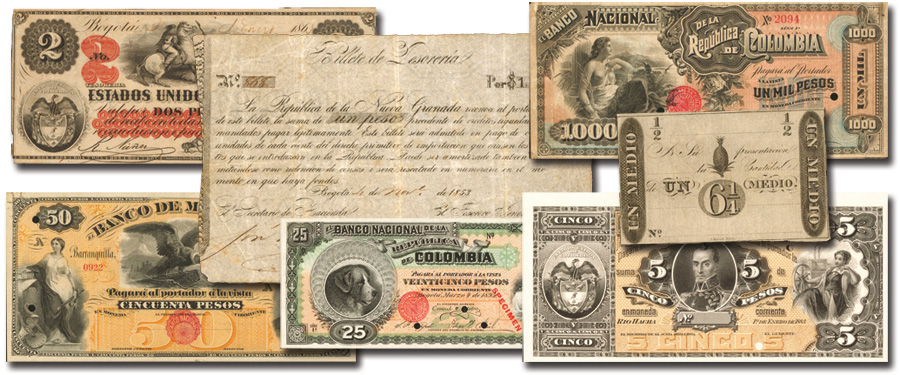
The Eldorado Collection
of Colombian Paper Money featured in this sale catalog, empirically portrays
the broadest view of this subject ever published in English or Spanish.
Commencing in 1819 and continuing to the present day are countless note types,
from the majority of known series and issuers, cataloged and offered in this
and subsequent sales for the first time. The lot descriptions and their
accompanying full-color images often confirm rumored examples listed, but
unpriced, in the Standard Catalog of World Paper Money (“Pick”). Many
are first time individual offerings at public auction. This is especially true
of previously unlisted types that were discovered in the Archives of the
American Bank Note Company, sold by Christie’s initially on November 28-29,
1990. Nearly all 66 Colombia lots enumerated in that “Leo” moniker catalog
(including two immense and unique record books) were obtained at the sale by
Eldorado’s architect, who recognized their immense research importance and the
opportunity to expand the collection’s scope in the span of a few hours.
Additional Colombia proof note groups were also purchased at the second World
Paper Money sale on June 5, 1991, at Christie’s. In the current sale are some
of the finest condition and rarest examples from those former ABN sale lots.
Colombia declared its
independence in 1810 from the Viceroyalty of New Granada. However, it was not
until 1819 that the independent nation was established and the first distinctly
Colombian paper money printed. These rare notes (Pick 1-4) were printed by
Peter Maverick in New York. Shortly after, a second Pesos denominated series
was printed with República de Colombia titles (Pick 5-8) and are styled
similarly to American obsolete private banknotes of the period. The short-lived
Gran Colombia these notes were printed for was succeeded in 1831 by the
Republic of New Granada, but a few decades would pass before paper money would
be printed again, this time locally. All the notes from this period are rare.
The collection includes a pair of unlisted Billete de Tesorería notes (lots
10003-10004) printed on watermarked paper. The Estados Unidos de Nueva
Granada-Tesorería Jeneral issue is well represented with three denominations.
Printed on frail paper, their condition is superior to most known to
collectors.
Colombia’s political
climate settled considerably in the early 1860s with the establishment of the
Estados Unidos de Colombia (1863-1886). This period is the “Golden Age” of
Colombian paper money, directly coinciding with its contracts with the American
Banknote Company in New York. The Latin American independent nations created by
Bolívar’s revolutions crisscrossed a continent with new clients for this giant
security printer. Not only did the United States of Colombia order its first
series of colorful engraved notes (Pick 74-78) from the ABNCo., but within ten
years many private banks and companies (the “bancos”) ordered notes to be
printed by them. Artistically, each individual bank’s designs, colors, and
features appear to be in competition with one another. Colombian notes from
this quarter century span are among the most beautifully engraved by the ABNCo.
The Eldorado Collection contains notes from nearly all these private issuers,
including those printed locally by D. Paredes, Bogotá.
Concurrent with the
issuance of the private “bancos,” commencing in the early 1880s, were notes
printed by the ABNCo. for the Banco Nacional. These “National Banknotes” were
backed by the federal authorities and this bank is the precursor of the current
banking system in Colombia today. In addition to issuing its own notes, the
bank apparently acted as the clearing house for the private banks. Eventually
there was too much paper money in circulation leading to the bank’s closing in
1894. Some of these events contributed to the economic and political
instability which culminated in the “1000 Days War” from 1899 to 1902.
Remainder notes from several of these private banks were overprinted for the
Banco Nacional in Bogotá during the civil war and the current sale includes the
widest selection of them cataloged individually in any auction sale.
The “1000 Days War”
created other locally printed, regional, and emergency issue paper money, much
of it crudely produced under difficult conditions. High grade notes are the
exception for these emergency notes due to the tropical climate and rag paper
used for these issues. Many of the Banco Nacional overprinted notes appear to
have been redeemed after the war and are rare. After this civil war, the
initial Banco de la República notes were printed by the ABNCo., but it would be
nearly two decades before a firmly established national bank would be created.
American Edwin Kemmerer
had already worked with other Latin American economies when he was summoned to
work with the Banco de la República for Colombia. In 1923, the Law 25 created
the bank which would authorize the Peso Oro on a gold standard, control
exchange rates, make loans and perform as a state bank. The 1923 Colombia
series and onward coincided with this law and are recorded in the second ABN
sale record book offered as lot 10564. The banknotes’ artistic styles from this
period become pedestrian in comparison to magnificent notes from the 1880s, but
many are rare as high grade issued notes. The 1938 400th Anniversary
of Bogotá Peso is an exception and was extremely well designed. The Proofs from
the second June 1991 ABN sale provide ample opportunities for collectors to
obtain Gem examples of these types.
The study of Colombian
paper money is amplified by this sale’s offerings and the opportunities
presented. These notes were curated with careful attention for decades and
often represent the only known examples or finest graded of their types.





